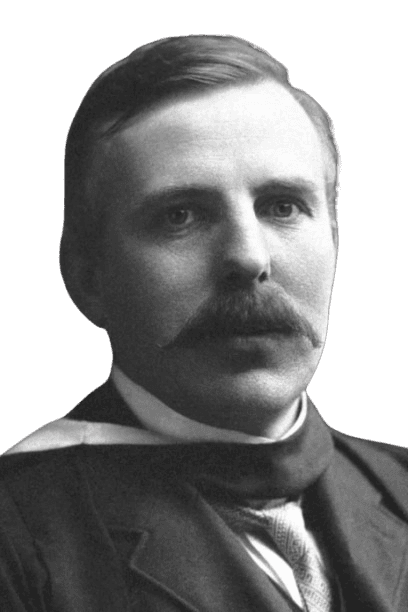Life and achievements
Early life
Sir Ernest Rutherford was born on August 30, 1871, in Brightwater, South Island of New Zealand. He was born the fourth of twelve children to James Rutherford, a farmer, and Martha Thompson, a school teacher. He had his childhood on his family farm, was hard-working, and was interested in science from an early age.
Rutherford's early schooling was at Foxhill School, followed by Nelson College in Nelson, New Zealand; he was a gifted student, particularly in mathematics and science. In 1890, he was offered a scholarship to study at Canterbury College in Christchurch, one of the four University of New Zealand campuses. Here, Rutherford developed a genuine love for scientific research, and his fascination with experimental physics started.
Rutherford proceeded to further his education after he obtained his Bachelor of Arts degree; he later obtained his Master of Arts in mathematics and physical science. His first studies of the magnetization of iron also paved the way for his subsequent important work, which aimed at discovering atomic physics. In 1895, Rutherford was given a scholarship to join the Cavendish Laboratory at the University of Cambridge, where J. J. Thomson supervised him.
Legacy
Ernest Rutherford has left a great heritage in the field of science and as a mentor for young scientists. He made some significant findings about the atomic nucleus and radioactivity that changed the course of physics for modern nuclear physics and quantum theory. Most importantly, Rutherford's gold foil experiment led to the formation of the atom model, which other scientists could elaborate on to gain further insights into the structure of atoms.
In addition to the scientific legacy, Rutherford contributed to developing scientific thought in terms of being a mentor. He worked and mentored other famous physicists such as Niels Bohr and James Chadwick. He influenced these scientists and could take the world of physics into the atomic age by their discovery of quantum mechanics and nuclear reactions. While at the Cavendish, Rutherford's laboratory became one of the most scientifically productive as the director.
Science was to feel Rutherford's influence long after he had passed on. The element rutherfordium, discovered in 1969, was named in his honor, the man who contributed so much to nuclear science. His name is associated with science, and his research still motivates physicists today.
Milestone moments
Aug 21, 1898
Identification of Alpha and Beta Rays
Ernest Rutherford, in 1898, when working at McGill University in Canada, identified two types of radiation from uranium.
Rutherford named them alpha and beta rays, and he was able to prove that the two were different.
This discovery was of immense importance in determining the characteristics of radioactive elements and paved the way for studying radioactivity.
His work at McGill helped him become one of his generation's leading physicists.
Nov 2, 1908
Nobel Prize in Chemistry
Rutherford, in 1908, was to be rewarded with the Nobel Prize in Chemistry for his work on the disintegration of elements.
This prestigious award honored his early work on radioactive decay and the chemical characteristics of radioactive materials.
This started a stream of awards accompanying him in his working years as a scientist.
The Nobel Prize was a culmination of a career that was already filled with many other breakthroughs.
Jul 22, 1911
Gold Foil Experiment
Rutherford's gold foil experiment, which he carried out in 1911, is considered a significant step in the field of physics.
In this case, the experiment involved the scattering of alpha particles on a thin sheet of gold.
Rutherford's observations forced him to arrive at a revolutionary conclusion that said the atom has a compact nucleus that is positively charged.
This experiment revolutionized the knowledge of the atomic structure, impacting generations of physicists.
Apr 17, 1917
The First Artificial Nuclear Reaction
In 1917, Rutherford made a remarkable discovery in science by successfully carrying out the first nuclear reaction.
He fired alpha particles on nitrogen atoms, and the nitrogen atoms were converted into oxygen.
This was the first time one element was turned into another, which would be the future focus of nuclear chemistry.
Rutherford's discovery was the foundation for future research on nuclear energy and reactions.
